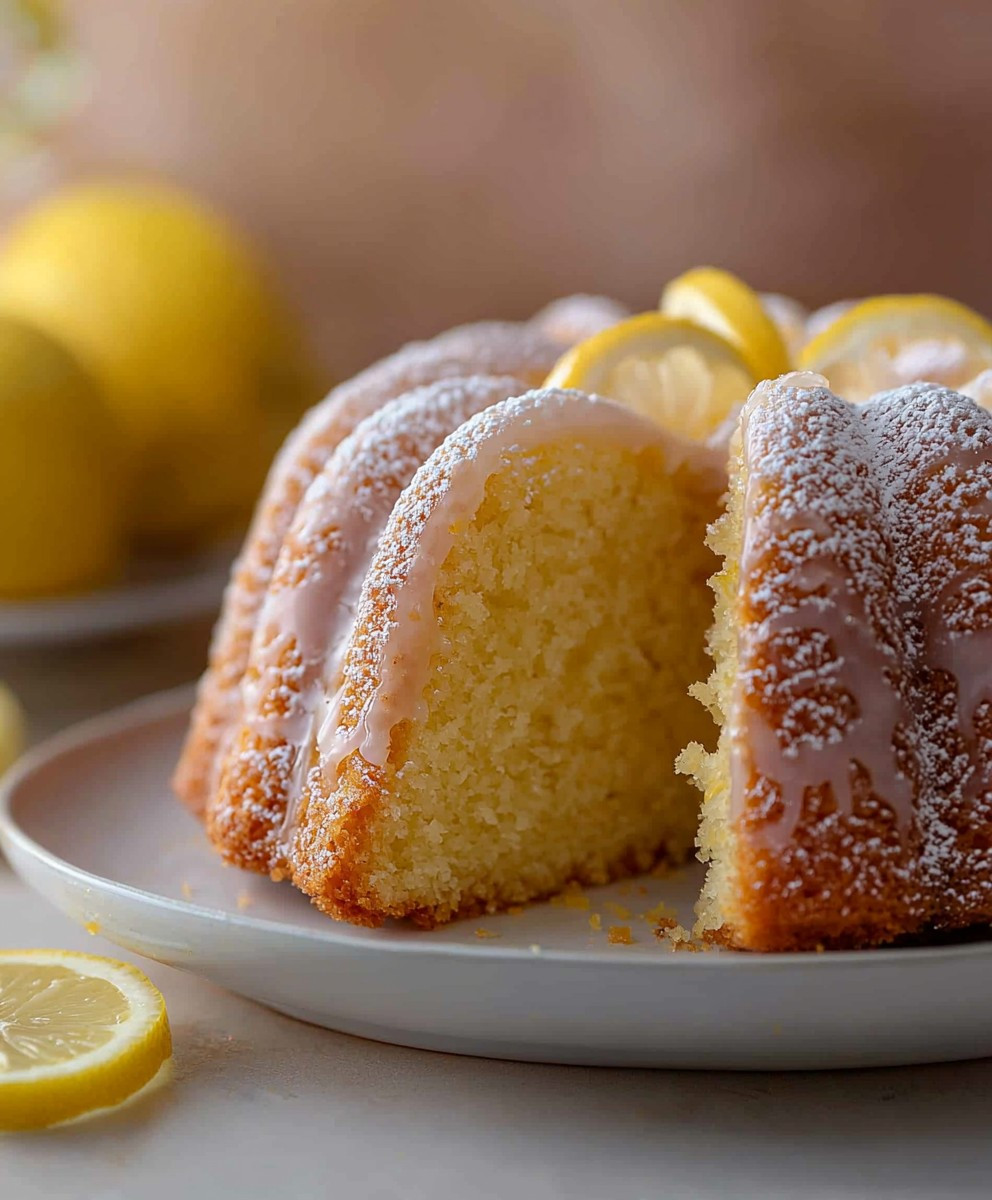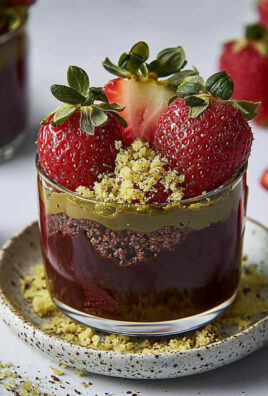Lemon Bundt Cake: just the name conjures up images of sunshine, bright flavors, and a dessert that’s as beautiful as it is delicious. Have you ever craved a cake that’s both comforting and sophisticated, perfect for a casual brunch or an elegant afternoon tea? Then look no further! This recipe delivers a moist, tender crumb infused with the zesty tang of lemon, all encased in the iconic, sculpted shape of a Bundt pan.
While the exact origins of the Bundt cake are debated, its popularity soared in the mid-20th century thanks to the Nordic Ware company, who trademarked the name “Bundt” and popularized the distinctive pan. The shape itself, reminiscent of European Gugelhupf cakes, allows for even baking and creates a stunning presentation with minimal effort. But beyond its visual appeal, the real magic of a Lemon Bundt Cake lies in its flavor profile. The bright, citrusy notes of lemon perfectly complement the rich, buttery cake, creating a harmonious balance that’s simply irresistible.
People adore this cake for so many reasons. Its moist texture is incredibly satisfying, and the vibrant lemon flavor is both refreshing and comforting. Plus, the Bundt shape makes it an impressive centerpiece for any occasion. Whether you’re a seasoned baker or just starting out, this recipe is surprisingly easy to follow, guaranteeing a show-stopping dessert that will impress your family and friends. Get ready to experience the joy of baking and savor every bite of this delightful treat!
Ingredients:
- For the Cake:
- 3 cups all-purpose flour
- 1 teaspoon baking powder
- 1/2 teaspoon baking soda
- 1/4 teaspoon salt
- 1 cup (2 sticks) unsalted butter, softened
- 2 1/2 cups granulated sugar
- 4 large eggs
- 1 cup sour cream
- 1/4 cup lemon juice, freshly squeezed
- 2 tablespoons lemon zest, finely grated
- 1 teaspoon vanilla extract
- For the Lemon Glaze:
- 2 cups powdered sugar
- 1/4 cup lemon juice, freshly squeezed (more or less to reach desired consistency)
- 1 tablespoon lemon zest, finely grated
- 1 tablespoon melted butter (optional, for extra shine)
Preparing the Cake Batter:
- Preheat and Prepare the Bundt Pan: First things first, let’s get our oven preheated to 350°F (175°C). This is crucial for even baking. While the oven is heating, generously grease and flour your bundt pan. I like to use baking spray that contains flour, but you can also use shortening or butter and then dust with flour. Make sure you get into all the nooks and crannies of the pan to prevent the cake from sticking. A well-greased and floured pan is your best friend when it comes to bundt cakes!
- Whisk Dry Ingredients: In a large bowl, whisk together the flour, baking powder, baking soda, and salt. Whisking ensures that the baking powder and soda are evenly distributed, which is essential for a light and airy cake. Don’t skip this step! It really makes a difference.
- Cream Butter and Sugar: In a separate large bowl (or the bowl of your stand mixer), cream together the softened butter and granulated sugar until light and fluffy. This usually takes about 3-5 minutes on medium speed. The mixture should be pale and airy. This step is important because it incorporates air into the batter, which helps the cake rise. Scrape down the sides of the bowl occasionally to ensure everything is evenly mixed.
- Add Eggs: Beat in the eggs one at a time, making sure each egg is fully incorporated before adding the next. After adding all the eggs, beat for another minute or two until the mixture is smooth and creamy. Again, scrape down the sides of the bowl as needed.
- Combine Wet and Dry Ingredients: In a small bowl, whisk together the sour cream, lemon juice, lemon zest, and vanilla extract. This mixture adds moisture and flavor to the cake. Now, gradually add the dry ingredients to the wet ingredients, alternating with the sour cream mixture. Begin and end with the dry ingredients. So, add about 1/3 of the dry ingredients, mix until just combined, then add 1/2 of the sour cream mixture, mix until just combined, then another 1/3 of the dry ingredients, mix, then the remaining sour cream mixture, mix, and finally the last 1/3 of the dry ingredients. Be careful not to overmix the batter. Overmixing can develop the gluten in the flour, resulting in a tough cake. Mix until just combined, and no streaks of flour remain.
Baking the Cake:
- Pour Batter into Pan: Carefully pour the batter into the prepared bundt pan, spreading it evenly. Gently tap the pan on the counter a few times to release any air bubbles. This will help prevent large holes in your cake.
- Bake: Bake in the preheated oven for 50-60 minutes, or until a wooden skewer inserted into the center comes out clean. The baking time may vary depending on your oven, so start checking for doneness around 50 minutes. If the top of the cake is browning too quickly, you can loosely tent it with aluminum foil.
- Cool in Pan: Once the cake is done, remove it from the oven and let it cool in the pan for 10-15 minutes. This allows the cake to firm up slightly, making it easier to remove from the pan.
- Invert onto Wire Rack: After 10-15 minutes, carefully invert the cake onto a wire rack to cool completely. If the cake doesn’t release easily, gently tap the pan or run a thin knife around the edges to loosen it. Make sure the cake is completely cool before glazing.
Preparing the Lemon Glaze:
- Whisk Ingredients: In a medium bowl, whisk together the powdered sugar, lemon juice, lemon zest, and melted butter (if using) until smooth. Start with 1/4 cup of lemon juice and add more, a tablespoon at a time, until you reach your desired consistency. The glaze should be thick enough to coat the cake but thin enough to drizzle.
- Adjust Consistency: If the glaze is too thick, add a little more lemon juice. If it’s too thin, add a little more powdered sugar. The key is to find the perfect balance.
Glazing and Serving:
- Glaze the Cake: Once the cake is completely cool, place it on a serving plate or cake stand. Drizzle the lemon glaze evenly over the cake, allowing it to drip down the sides. You can drizzle it all at once for a thick coating, or do a few thinner layers, letting each layer set slightly before adding the next.
- Let Glaze Set: Allow the glaze to set for about 15-20 minutes before serving. This will prevent it from being too sticky.
- Serve and Enjoy: Slice the cake and serve. This Lemon Bundt Cake is delicious on its own, or you can serve it with a dollop of whipped cream or a scoop of vanilla ice cream. Enjoy!

Conclusion:
This Lemon Bundt Cake isn’t just another cake recipe; it’s a burst of sunshine in every slice, a guaranteed crowd-pleaser, and, frankly, a must-have in your baking repertoire. The moist, tender crumb, the tangy lemon glaze, and the elegant presentation of the Bundt shape all combine to create a truly unforgettable dessert experience. I know I’m biased, but I genuinely believe this is the best lemon cake I’ve ever made, and I’m confident you’ll feel the same way. Why is it a must-try? Because it’s incredibly easy to make, even for beginner bakers. The ingredients are simple and readily available, and the steps are straightforward. Plus, the results are consistently impressive. You don’t need to be a pastry chef to whip up a cake that looks and tastes like it came from a high-end bakery. The bright, refreshing lemon flavor is perfect for any occasion, from a casual afternoon tea to a celebratory dinner party. It’s a cake that effortlessly elevates any gathering. But the best part? It’s incredibly versatile! While the classic lemon glaze is divine, feel free to experiment with different toppings. A dusting of powdered sugar adds a touch of elegance, while a drizzle of white chocolate provides a decadent twist. For a more intense lemon flavor, try adding lemon zest to the glaze. You could even incorporate other citrus fruits, like orange or grapefruit, for a unique and exciting flavor profile. Serving Suggestions and Variations: * Serve slices of the cake with a dollop of whipped cream or a scoop of vanilla ice cream for an extra special treat. * Pair it with a cup of hot tea or coffee for a cozy afternoon indulgence. * For a brunch gathering, offer a selection of fresh berries alongside the cake. * Consider making mini Bundt cakes for individual servings they’re perfect for parties! * If you’re feeling adventurous, try adding a layer of lemon curd to the center of the cake before baking. I truly believe that this Lemon Bundt Cake will become a staple in your kitchen. It’s a recipe that you’ll turn to time and time again, whether you’re baking for yourself, your family, or a group of friends. The joy of sharing a homemade cake is unparalleled, and this recipe is guaranteed to bring smiles to everyone’s faces. So, what are you waiting for? Preheat your oven, gather your ingredients, and get ready to bake! I’m so excited for you to try this recipe and experience the magic of this Lemon Bundt Cake for yourself. And most importantly, I want to hear about your experience! Did you make any variations? Did you serve it with anything special? What did your friends and family think? Please, share your photos and stories in the comments below. I can’t wait to see your creations and hear all about your baking adventures. Happy baking! Print
Lemon Bundt Cake: The Ultimate Recipe for a Zesty Delight
- Total Time: 90 minutes
- Yield: 12–16 servings 1x
Description
A bright and tangy Lemon Bundt Cake with a zesty lemon glaze. Perfect for any occasion!
Ingredients
- 3 cups all-purpose flour
- 1 teaspoon baking powder
- 1/2 teaspoon baking soda
- 1/4 teaspoon salt
- 1 cup (2 sticks) unsalted butter, softened
- 2 1/2 cups granulated sugar
- 4 large eggs
- 1 cup sour cream
- 1/4 cup lemon juice, freshly squeezed
- 2 tablespoons lemon zest, finely grated
- 1 teaspoon vanilla extract
- 2 cups powdered sugar
- 1/4 cup lemon juice, freshly squeezed (more or less to reach desired consistency)
- 1 tablespoon lemon zest, finely grated
- 1 tablespoon melted butter (optional, for extra shine)
Instructions
- Preheat oven to 350°F (175°C). Grease and flour a bundt pan thoroughly.
- In a large bowl, whisk together the flour, baking powder, baking soda, and salt.
- In a separate large bowl, cream together the softened butter and granulated sugar until light and fluffy (3-5 minutes). Scrape down the sides of the bowl as needed.
- Beat in the eggs one at a time, ensuring each egg is fully incorporated before adding the next. Beat for another minute or two until smooth and creamy.
- In a small bowl, whisk together the sour cream, lemon juice, lemon zest, and vanilla extract. Gradually add the dry ingredients to the wet ingredients, alternating with the sour cream mixture, beginning and ending with the dry ingredients. Mix until just combined, being careful not to overmix.
- Carefully pour the batter into the prepared bundt pan, spreading it evenly. Gently tap the pan on the counter to release any air bubbles.
- Bake in the preheated oven for 50-60 minutes, or until a wooden skewer inserted into the center comes out clean. Tent with foil if browning too quickly.
- Once the cake is done, remove it from the oven and let it cool in the pan for 10-15 minutes.
- After 10-15 minutes, carefully invert the cake onto a wire rack to cool completely.
- In a medium bowl, whisk together the powdered sugar, lemon juice, lemon zest, and melted butter (if using) until smooth.
- Add more lemon juice or powdered sugar to reach desired consistency.
- Once the cake is completely cool, place it on a serving plate. Drizzle the lemon glaze evenly over the cake.
- Allow the glaze to set for about 15-20 minutes before serving.
- Slice the cake and serve.
Notes
- Make sure your butter is properly softened for easy creaming.
- Don’t overmix the batter, as this can lead to a tough cake.
- Greasing and flouring the bundt pan thoroughly is crucial for easy release.
- Adjust the lemon juice in the glaze to achieve your desired consistency.
- For extra shine, add melted butter to the glaze.
- Prep Time: 25 minutes
- Cook Time: 50 minutes




